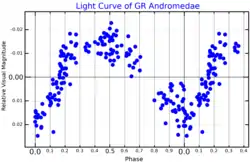GR Andromedae (often abbreviated to GR And) is a variable star in the constellation Andromeda. Its apparent visual magnitude varies between 6.87 and 6.95 in a cycle of 518.2 days.[1] It is classified as an α2 Canum Venaticorum variable.[3]
Spectrum
The radiation emitted by GP Andromedae is a typical stellar blackbody with absorption lines from various elements, which gives to the star a spectral type A2pSrCrEu, meaning that unusually strong lines of strontium, chromium and europium can be observed.[3] GP Andromedae is thus classified as an Ap star. The intensity and profile of the spectral lines varies within a cycle with the same period as the brightness variations.[8]
Variability
Photometric and spectral variability of GR Andromedae is typical of a star with a strong and variable magnetic field. This way, the 518.2 days periodicity can be identified as the rotation period of the star.[8] It's among the slowest rotators in the category of magnetic chemically peculiar stars, with a calculated equatorial rotation rate of only 0.2 km/s.[1]
References
- 1 2 3 4 Pyper, D. M.; Adelman, S. J. (October 2017). "On the Photometric Variability of Very Sharp-lined Cool mCP Stars". Publications of the Astronomical Society of the Pacific. 129 (980): 104203. Bibcode:2017PASP..129j4203P. doi:10.1088/1538-3873/aa7c9e.
- 1 2 3 4 5 6 Brown, A. G. A.; et al. (Gaia collaboration) (August 2018). "Gaia Data Release 2: Summary of the contents and survey properties". Astronomy & Astrophysics. 616. A1. arXiv:1804.09365. Bibcode:2018A&A...616A...1G. doi:10.1051/0004-6361/201833051. Gaia DR2 record for this source at VizieR.
- 1 2 3 4 5 GR And, database entry, Combined General Catalog of Variable Stars (GCVS4.2, 2004 Ed.), N. N. Samus, O. V. Durlevich, et al., CDS ID II/250 Accessed on line 2018-10-17.
- 1 2 "GR And". SIMBAD. Centre de données astronomiques de Strasbourg. Retrieved November 8, 2018.
- 1 2 3 Cutri, Roc M.; Skrutskie, Michael F.; Van Dyk, Schuyler D.; Beichman, Charles A.; Carpenter, John M.; Chester, Thomas; Cambresy, Laurent; Evans, Tracey E.; Fowler, John W.; Gizis, John E.; Howard, Elizabeth V.; Huchra, John P.; Jarrett, Thomas H.; Kopan, Eugene L.; Kirkpatrick, J. Davy; Light, Robert M.; Marsh, Kenneth A.; McCallon, Howard L.; Schneider, Stephen E.; Stiening, Rae; Sykes, Matthew J.; Weinberg, Martin D.; Wheaton, William A.; Wheelock, Sherry L.; Zacarias, N. (2003). "VizieR Online Data Catalog: 2MASS All-Sky Catalog of Point Sources (Cutri+ 2003)". CDS/ADC Collection of Electronic Catalogues. 2246: II/246. Bibcode:2003yCat.2246....0C.
- ↑ Gontcharov, G. A. (November 2006). "Pulkovo Compilation of Radial Velocities for 35 495 Hipparcos stars in a common system". Astronomy Letters. 32 (11): 759–771. arXiv:1606.08053. Bibcode:2006AstL...32..759G. doi:10.1134/S1063773706110065. S2CID 119231169.
- 1 2 3 4 Kochukhov, O.; Bagnulo, S. (2006). "Evolutionary state of magnetic chemically peculiar stars". Astronomy and Astrophysics. 450 (2): 763. arXiv:astro-ph/0601461. Bibcode:2006A&A...450..763K. doi:10.1051/0004-6361:20054596. S2CID 18596834.
- 1 2 3 4 Catalano, F. A.; Leone, F. (June 1990). "Photoelectric photometry of chemically peculiar stars at the Catania astrophysical observatory. Observatory of HD 2453, HD 71866, HD 72968 and HD 126515". Astronomy and Astrophysics Supplement Series. 83: 491. Bibcode:1990A&AS...83..491C.
- 1 2 3 Soubiran, Caroline; et al. (2016), "The PASTEL catalogue: 2016 version", Astronomy & Astrophysics, 591: A118, arXiv:1605.07384, Bibcode:2016A&A...591A.118S, doi:10.1051/0004-6361/201628497, S2CID 119258214.
